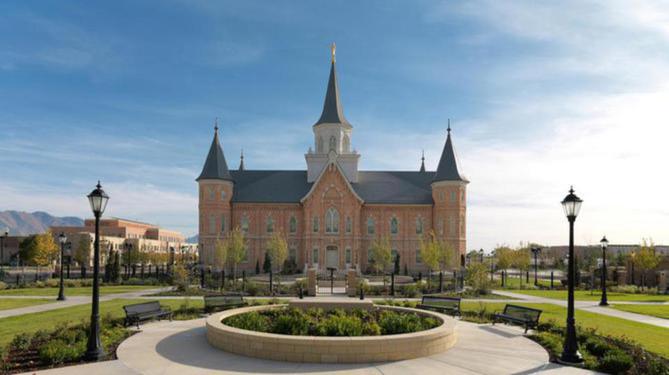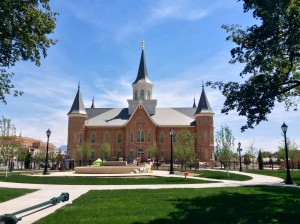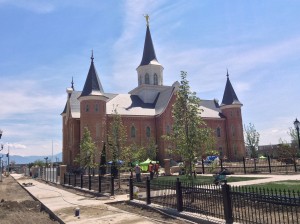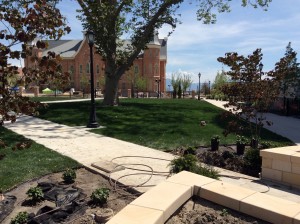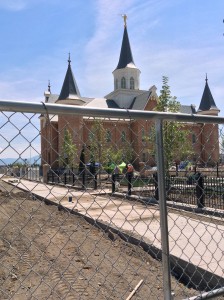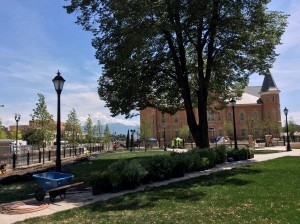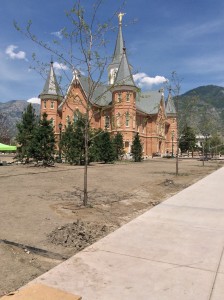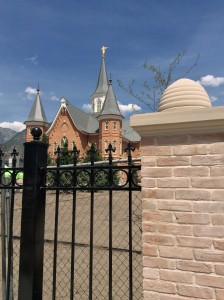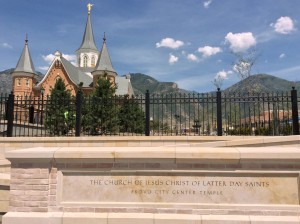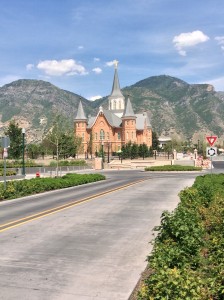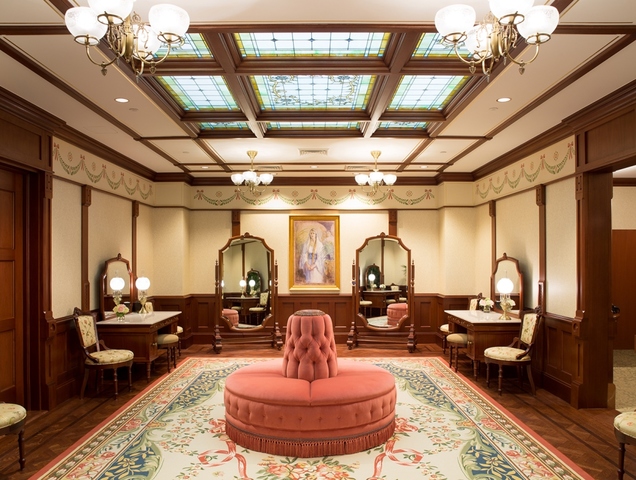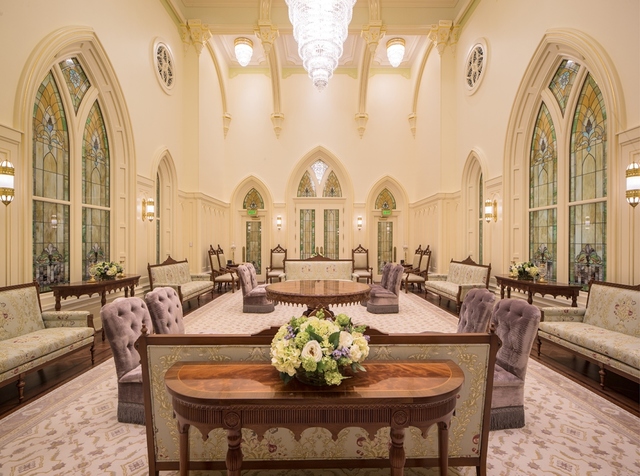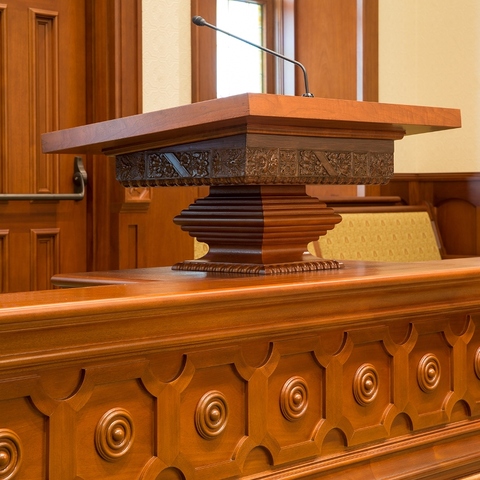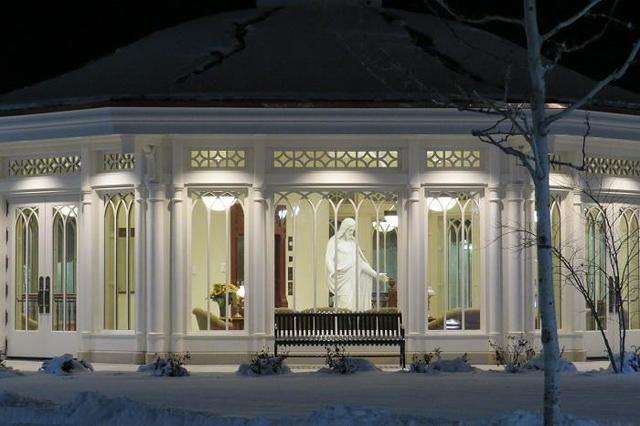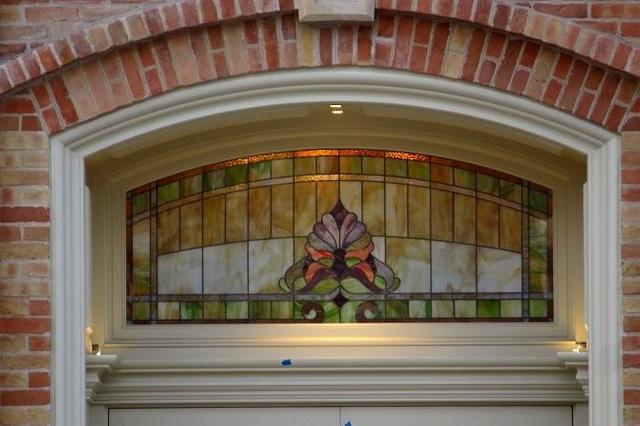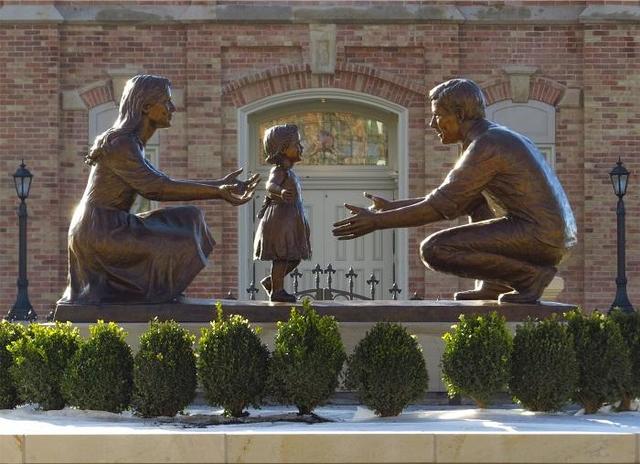Difference between revisions of "Provo City Center Temple"
m |
|||
| (56 intermediate revisions by 2 users not shown) | |||
| Line 1: | Line 1: | ||
| − | [[Image:provo-city-center | + | [[Image:provo-city-center-temple.jpg|400px|thumb|alt=Provo City Center Temple|right|frame|<span style="color:#0D8ED3">The north side of the Provo City Center Temple. (Church Newsroom)]] |
| − | + | The '''Provo City Center Temple''' is the 150th temple in operation belonging to [http://comeuntochrist.org The Church of Jesus Christ of Latter-day Saints]. Its history is unique. | |
| − | + | When a fire tragically gutted the iconic Provo Utah Tabernacle in the early morning of [http://www.mormonnewsroom.org/article/fire-damages-historic-provo-tabernacle 17 December 2010], questions immediately arose about what to do with the remains and grounds of the building, which had been a city landmark for more than 100 years. The beautiful structure, built between 1883 and 1898, was venerated by Provo residents and generations of [[Brigham Young University]] students who used it for church meetings and concerts. | |
| − | + | The early Latter-day Saints built the Provo Utah Tabernacle to be used as a meeting place. The edifice was dedicated in April 1898 by [[George Q. Cannon]], then serving as a member of the [[First Presidency]] of the Church of Jesus Christ. Over 4,000 people were in attendance, both inside and outside the building. President Cannon was accompanied by [[Joseph F. Smith]], [[John Henry Smith]], [[Heber J. Grant]], [[Reed Smoot]] and local leader [[Karl G. Maeser|Dr. Karl G. Maeser]]. The building was used not only to host a few sessions of [[General Conference]] (in 1886 and 1887), but also became a venue for over a century of concerts, conferences, graduation ceremonies, and funerals. [http://www.deseretnews.com/article/705331478/Taft-left-a-big-impression-on-Utahns-in-1909.html?pg=all U.S. President, William H. Taft], visited Utah on 24 - 26 September 1909 and gave an address in the Tabernacle prior to going to Salt Lake City, and Sergei Rachmaninoff filled its hall with his music in 1938. Over the years many special guests such renowned musician John Phillip Sousa, Helen Keller, and poet Robert Frost visited the Provo Tabernacle. | |
| − | + | On 1 October 2011 at the 181st Semiannual General Conference of the Church of Jesus Christ, Prophet [[Thomas S. Monson]] addressed the future of the remains of this tabernacle. | |
| − | + | :First, may I mention that no Church-built facility is more important than a temple. Temples are places where relationships are sealed together to last through the eternities. We are grateful for all the many temples across the world and for the blessing they are in the lives of our members. | |
| − | + | :Late last year the Provo Tabernacle in Utah County was seriously damaged by a terrible fire. This wonderful building, much beloved by generations of Latter-day Saints, was left with only the exterior walls standing. After careful study, we have decided to rebuild it with full preservation and restoration of the exterior, to become the second temple of the Church in the city of Provo. The existing Provo Temple is one of the busiest in the Church, and a second temple there will accommodate the increasing numbers of faithful Church members who are attending the temple from Provo and the surrounding communities.[https://www.churchofjesuschrist.org/study/general-conference/2011/10/as-we-meet-again?lang=eng] | |
| − | + | An audible gasp of joy filled the [[Conference Center]]. | |
| − | + | ==A Temple Rises from the Ashes== | |
| − | + | Patterned after a similar situation with the 1997 dedication of the [[Vernal Utah Temple]], which was built from the Uintah Stake Tabernacle of the early 1900s, this second Provo temple includes a complete restoration of the original exterior design of the Provo Tabernacle. The Provo City Center Temple was the fourth temple built from an existing building. | |
| − | The restoration of the Provo City Center Tabernacle | + | :Perhaps the most remarkable discovery made among the ashes the day after the fire was a giclee print of The Second Coming by Harry Anderson, which depicts Jesus Christ coming through the clouds with heralding angels on either side—a picture frequently featured in Latter-day Saint temples. The tabernacle painting, which sat inside the east front door, was completely blackened by residual fire except for the untouched figure of Jesus Christ himself with hands outstretched. Those who saw the painting in person were awestruck. Officials directed the print to be removed immediately for conservation and stabilization. It was handled with the greatest care, wrapped in plastic, and loaded into a waiting truck. The extraordinary occurrence was dubbed by some to be a "Christmas miracle."[https://www.heraldextra.com/special-section/2010/dec/18/scorched-portrait-of-christ-saved-from-tabernacle/] |
| + | |||
| + | Kirk Dickamore, vice president of Jacobsen Construction Co., said Jacobsen was on site the day after the fire to begin clearing away the smoldering ruins. Over several weeks, the company removed 14 tons of debris from the site. It then designed and erected a one-of-a-kind exterior shoring system to hold the walls in place until the structure’s future could be determined. After President Monson's announcement, Jacobsen Construction continued their work. "Countless opportunities for innovation presented themselves, Dickamore said, including strengthening the exterior. That was accomplished by removing two of five layers of brick from the interior and securing the remaining layers with steel ties. A two-layer grid of rebar was then erected inside the perimeter and filled with concrete. | ||
| + | |||
| + | "Another innovation seemed to defy gravity, as the entire 6.8 million-pound exterior shell was placed onto 40-foot-high steel stilts, enabling the excavation of the ground beneath for construction of a basement | ||
| + | |||
| + | “'For many weeks it appeared as if the building were hovering in mid-air,' he said. | ||
| + | |||
| + | “'Finally, it was time for this 126-year-old structure to literally rise from the ashes and transcend into a facility that exceeded its original splendor,' he said. 'Original brick, salvaged at numerous stockpiles in the area, was sourced to create a seamless exterior.' | ||
| + | |||
| + | "Painstaking craftsmanship in millwork, windows and wall murals have added to an edifice that is “breathtaking and unmatched,” he said, quoting President Monson to the effect that temples are a collective expression of the testimony of Church members."[https://www.thechurchnews.com/2015/11/19/23213635/rising-from-the-ashes-experts-discuss-new-provo-city-center-temple] | ||
| + | |||
| + | Many design patterns and historic details from the original tabernacle were replicated into the new temple. | ||
| + | |||
| + | In August 2011, the Church announced the purchase of land from two nearby businesses (Travelodge Motel and Los 3 Amigos restaurant). The following month, the Provo Municipal Council passed a vote to sell to the Church the land on which the Hotel Roberts stood before it was demolished in 2004. The Church owns the entire block on which the Provo City Center Temple stands, with the exception of the property belonging to the U.S. Post Office, and has indicated no plans to pursue ownership of that portion of land. | ||
| + | |||
| + | The restoration of the Provo City Center Tabernacle attracted many people who wanted to see history in the making as the pioneer-era landmark was transformed into what Latter-day Saints believe is a “House of the Lord.” | ||
| + | |||
| + | Construction on the Provo City Center Temple was finished December 17, 2015, exactly five years — to the day — after the Provo Tabernacle was destroyed by a fire. | ||
| + | |||
| + | <embedvideo service="youtube" urlargs="rel=0" dimensions="400" alignment="inline">https://youtube.com/watch?v=MVoZ_5kGhqc&rel=0</embedvideo> | ||
==Picture Gallery of Provo City Center Temple== | ==Picture Gallery of Provo City Center Temple== | ||
| Line 35: | Line 55: | ||
</gallery> | </gallery> | ||
| − | Here are | + | Here are pictures of the Provo City Center Temple taken in 2015. All images were downloaded from the 8 July 2015 article by Amy Tanner Thiriot [http://www.keepapitchinin.org/2015/07/08/provo-city-center-temple/ "New Views of the Provo City Center Temple"]. |
| + | |||
| + | ==Pavilion on the Temple Grounds== | ||
| + | |||
| + | The Provo City Center Temple grounds includes a two-story, 5,000 square foot pavilion, located approximately midway between 100 and 200 South. It serves as a waiting area for non-temple patrons and a place for wedding parties to take pictures. | ||
| + | |||
| + | ==Open House and Cultural Celebration for Provo City Center Temple== | ||
| + | |||
| + | The temple open house was held from 15 January 2016 through 5 March 2016, excepting Sundays. | ||
| + | |||
| + | On Saturday evening, 19 March 2016, approximately 4,500 youth joined together to celebrate the completion of the 150th temple for The Church of Jesus Christ of Latter-day Saints, and to commemorate the heritage of the Provo region through narration, song, and dance. The cultural celebration took place at the Marriott Center in Provo, Utah. Before the celebration began, Elder [[Dallin H. Oaks]] of the [[Quorum of the Twelve Apostles]] addressed the youth from the Provo and Springville area stakes. Many other Church leaders attended the event, including youth general auxiliary leaders. The theme of the celebration was "Beauty for Ashes" (see [https://www.lds.org/scriptures/ot/isa/61.3?lang=eng#2 Isaiah 61:3]) which represented the old Provo Tabernacle that was gutted by fire in 2010 being transformed into a beautiful sacred edifice. | ||
| + | |||
| + | One of the participants, 17-year-old Zack Sink, who remembers seeing the smoke from the temple as he was sitting on a bus on the way to school, commented, "It is a beacon of hope to me in my life." And Isai Sanchez, 14, commented that all of the hard work, practices and even learning to dance has been a good experience “because it is for something special. And I can tell future generations I danced for that temple." | ||
| − | == | + | ==First Official Photos Released: Provo City Center Temple Inside and Outside== |
| + | |||
| + | All images were downloaded from the 5 January 2016 article by the LDS Living Staff [http://www.ldsliving.com/Interior-Photos-Provo-City-Center-Temple/s/80971 First Official Photos: Inside the Provo City Center Temple]. The outside photos are from [http://www.ldschurchtemples.com/provocitycenter/construction/ ldschurchtemples.com]. | ||
| + | |||
| + | <gallery class="center" mode=packed-hover> | ||
| + | File:provo-city-center-temple-brides-room.jpg|Provo City Center Temple Brides Room | ||
| + | File:provo-city-center-temple-sealing-room.jpg|Provo City Center Temple Sealing Room | ||
| + | File:provo-city-center-temple-celestial-room.jpg|Provo City Center Temple Celestial Room | ||
| + | File:provo-city-center-temple-original-tabernacle-pulpit.jpg|Provo City Center Temple - Original Tabernacle Pulpit | ||
| + | File:provo-city-center-temple-christus-statue.jpg|Provo City Center Temple - Christus Statue Outside: Photo taken December 26, 2015, by Julie C. Markham | ||
| + | File:provo-city-center-temple-fountain.jpg|Provo City Center Temple - Fountain | ||
| + | File:provo-city-center-temple-stained-glass-window.jpg|Provo City Center Temple - Stained Glass Window: Photo taken December 7, 2015, by Julie C. Markham | ||
| + | File:provo-city-center-temple-the-family.jpg|Provo City Center Temple - The Family Statue: Photo taken December 11, 2015, by Julie C. Markham | ||
| + | </gallery> | ||
| − | + | ==Temple Dedication== | |
| − | + | The Provo City Center Temple was dedicated in three sessions on Sunday, 20 March 2016 by Elder [[Dallin H. Oaks]] of the [[Quorum of the Twelve Apostles]]. The dedication took place on the 115th anniversary of the death of [http://www.findagrave.com/cgi-bin/fg.cgi?page=gr&GRid=24642181 William Harrison Folsom], the original architect of the Provo Tabernacle. | |
| − | The | + | The dedicatory sessions were held at 9:00 a.m., 12:00 p.m. and 3:00 p.m. MDT, and broadcast to Utah meetinghouses. The normal three-hour block of meetings were cancelled to allow members to participate in the sacred events. Tickets, distributed through local church leaders, were required to view the broadcast. A cornerstone ceremony, with music provided by the Mormon Tabernacle Choir, took place at the southeast corner of the temple at the start of the first dedicatory session. Elder Oaks and Elders [[Lynn G. Robbins]] of the [[Presidency of the Seventy]], Elder [[Kent F. Richards]] and the new temple presidency, helped secure the cornerstone with mortar, the symbolic completion of the temple. Elder Oaks also invited a young woman and young man to place mortar around the cornerstone to represent, what he called, “The rising generation that will come to the temple in the future.” |
| − | The | + | The temple serves Latter-day Saints living in 29 stakes in Provo and Springville, including university student and single-adult stakes. |
| − | + | Mariah Proctor in her Meridian Magazine article titled "[http://ldsmag.com/provo-city-center-temple-a-mighty-change-at-the-heart/ Provo City Center Temple: A Mighty Change at the Heart]" published on 12 November 2015 noted: | |
| − | + | :One of the most striking parts of the whole history and now conversion of the Provo Tabernacle into the Provo City Center Temple is all of the stories. The structure has already been a part of thousands of lives. From those that walked door to door collecting funds for the original building to the owner of a single shoe left there in the 19th century and found in the excavations, those that met their spouses at events there, heard speakers that changed their testimonies forever or sat in their graduation ceremonies in those seats, nervous about what to do next. And that’s before the hundreds of people that have worked to convert the building into a temple even came on the scene. | |
| − | + | <noinclude> | |
| + | [[Category:Templates]] | ||
| + | </noinclude> | ||
| + | ==Videos== | ||
| + | <embedvideo service="youtube" urlargs="rel=0" dimensions="400" alignment="inline">https://youtube.com/watch?v=1h6NPMglZaI&rel=0</embedvideo> | ||
| − | + | <embedvideo service="youtube" urlargs="rel=0" dimensions="400" alignment="inline">https://youtube.com/watch?v=ifBc7uI3iUE&rel=0</embedvideo> | |
| − | == | + | <embedvideo service="youtube" urlargs="rel=0" dimensions="400" alignment="inline">https://youtube.com/watch?v=raZ4P22wzgg&rel=0</embedvideo> |
| − | + | <embedvideo service="youtube" urlargs="rel=0" dimensions="400" alignment="inline">https://youtube.com/watch?v=1lZh7ecOSlg&rel=0</embedvideo> | |
| − | + | <embedvideo service="youtube" urlargs="rel=0" dimensions="400" alignment="inline">https://youtube.com/watch?v=rJFHrx3p8BI&rel=0</embedvideo> | |
| − | + | <embedvideo service="youtube" urlargs="rel=0" dimensions="400" alignment="inline">https://youtube.com/watch?v=_ag2Yrx_uPc&rel=0</embedvideo> | |
| − | < | + | <embedvideo service="youtube" urlargs="rel=0" dimensions="400" alignment="inline">https://youtube.com/watch?v=bGLBo02IvSM&rel=0</embedvideo> |
| − | < | + | <embedvideo service="youtube" urlargs="rel=0" dimensions="400" alignment="inline">https://youtube.com/watch?v=lXLEODwYTGk&rel=0</embedvideo> |
| − | == | + | ==External Links== |
| − | * | + | * [https://www.churchofjesuschrist.org/temples/details/provo-city-center-temple?lang=eng Official Provo City Center Temple page] |
| + | * [https://churchofjesuschristtemples.org/provo-city-center-temple/ Provo City Center Temple page] | ||
| + | * [https://www.thechurchnews.com/2015/11/19/23213635/rising-from-the-ashes-experts-discuss-new-provo-city-center-temple Church News, "Rising from the Ashes: Experts Discuss New Provo City Center Temple," by R. Scott Lloyd] | ||
| + | * [http://ldsmag.com/provo-city-center-temple-a-mighty-change-at-the-heart/ Provo City Center Temple: A Mighty Change at the Heart] by Mariah Proctor | ||
| + | * [http://www.ldsliving.com/Why-Cedar-City-and-2-Other-LDS-Temples-Have-Stained-Glass-Windows-Rescued-from-a-Presbyterian-Church/s/83561 Why Cedar City and 2 Other LDS Temples Have Stained Glass Windows Rescued from a Presbyterian Church] | ||
| + | * [https://history.lds.org/exhibit/provo-city-center-temple?lang=eng Tabernacle to Temple: Provo’s Legacy of Worship] | ||
| + | * [https://www.familysearch.org/rootstech/session/a-prophets-temple-invitation-president-russell-m-nelson?lang=eng FamilySearch RootsTech, Temple Invitation by Russell M. Nelson] | ||
| + | {{TemplesUtah}} | ||
[[Category:Temples]] | [[Category:Temples]] | ||
Latest revision as of 15:59, 30 March 2024
The Provo City Center Temple is the 150th temple in operation belonging to The Church of Jesus Christ of Latter-day Saints. Its history is unique.
When a fire tragically gutted the iconic Provo Utah Tabernacle in the early morning of 17 December 2010, questions immediately arose about what to do with the remains and grounds of the building, which had been a city landmark for more than 100 years. The beautiful structure, built between 1883 and 1898, was venerated by Provo residents and generations of Brigham Young University students who used it for church meetings and concerts.
The early Latter-day Saints built the Provo Utah Tabernacle to be used as a meeting place. The edifice was dedicated in April 1898 by George Q. Cannon, then serving as a member of the First Presidency of the Church of Jesus Christ. Over 4,000 people were in attendance, both inside and outside the building. President Cannon was accompanied by Joseph F. Smith, John Henry Smith, Heber J. Grant, Reed Smoot and local leader Dr. Karl G. Maeser. The building was used not only to host a few sessions of General Conference (in 1886 and 1887), but also became a venue for over a century of concerts, conferences, graduation ceremonies, and funerals. U.S. President, William H. Taft, visited Utah on 24 - 26 September 1909 and gave an address in the Tabernacle prior to going to Salt Lake City, and Sergei Rachmaninoff filled its hall with his music in 1938. Over the years many special guests such renowned musician John Phillip Sousa, Helen Keller, and poet Robert Frost visited the Provo Tabernacle.
On 1 October 2011 at the 181st Semiannual General Conference of the Church of Jesus Christ, Prophet Thomas S. Monson addressed the future of the remains of this tabernacle.
- First, may I mention that no Church-built facility is more important than a temple. Temples are places where relationships are sealed together to last through the eternities. We are grateful for all the many temples across the world and for the blessing they are in the lives of our members.
- Late last year the Provo Tabernacle in Utah County was seriously damaged by a terrible fire. This wonderful building, much beloved by generations of Latter-day Saints, was left with only the exterior walls standing. After careful study, we have decided to rebuild it with full preservation and restoration of the exterior, to become the second temple of the Church in the city of Provo. The existing Provo Temple is one of the busiest in the Church, and a second temple there will accommodate the increasing numbers of faithful Church members who are attending the temple from Provo and the surrounding communities.[1]
An audible gasp of joy filled the Conference Center.
Contents
- 1 A Temple Rises from the Ashes
- 2 Picture Gallery of Provo City Center Temple
- 3 Pavilion on the Temple Grounds
- 4 Open House and Cultural Celebration for Provo City Center Temple
- 5 First Official Photos Released: Provo City Center Temple Inside and Outside
- 6 Temple Dedication
- 7 Videos
- 8 External Links
- 9 Temples in Utah
A Temple Rises from the Ashes
Patterned after a similar situation with the 1997 dedication of the Vernal Utah Temple, which was built from the Uintah Stake Tabernacle of the early 1900s, this second Provo temple includes a complete restoration of the original exterior design of the Provo Tabernacle. The Provo City Center Temple was the fourth temple built from an existing building.
- Perhaps the most remarkable discovery made among the ashes the day after the fire was a giclee print of The Second Coming by Harry Anderson, which depicts Jesus Christ coming through the clouds with heralding angels on either side—a picture frequently featured in Latter-day Saint temples. The tabernacle painting, which sat inside the east front door, was completely blackened by residual fire except for the untouched figure of Jesus Christ himself with hands outstretched. Those who saw the painting in person were awestruck. Officials directed the print to be removed immediately for conservation and stabilization. It was handled with the greatest care, wrapped in plastic, and loaded into a waiting truck. The extraordinary occurrence was dubbed by some to be a "Christmas miracle."[2]
Kirk Dickamore, vice president of Jacobsen Construction Co., said Jacobsen was on site the day after the fire to begin clearing away the smoldering ruins. Over several weeks, the company removed 14 tons of debris from the site. It then designed and erected a one-of-a-kind exterior shoring system to hold the walls in place until the structure’s future could be determined. After President Monson's announcement, Jacobsen Construction continued their work. "Countless opportunities for innovation presented themselves, Dickamore said, including strengthening the exterior. That was accomplished by removing two of five layers of brick from the interior and securing the remaining layers with steel ties. A two-layer grid of rebar was then erected inside the perimeter and filled with concrete.
"Another innovation seemed to defy gravity, as the entire 6.8 million-pound exterior shell was placed onto 40-foot-high steel stilts, enabling the excavation of the ground beneath for construction of a basement
“'For many weeks it appeared as if the building were hovering in mid-air,' he said.
“'Finally, it was time for this 126-year-old structure to literally rise from the ashes and transcend into a facility that exceeded its original splendor,' he said. 'Original brick, salvaged at numerous stockpiles in the area, was sourced to create a seamless exterior.'
"Painstaking craftsmanship in millwork, windows and wall murals have added to an edifice that is “breathtaking and unmatched,” he said, quoting President Monson to the effect that temples are a collective expression of the testimony of Church members."[3]
Many design patterns and historic details from the original tabernacle were replicated into the new temple.
In August 2011, the Church announced the purchase of land from two nearby businesses (Travelodge Motel and Los 3 Amigos restaurant). The following month, the Provo Municipal Council passed a vote to sell to the Church the land on which the Hotel Roberts stood before it was demolished in 2004. The Church owns the entire block on which the Provo City Center Temple stands, with the exception of the property belonging to the U.S. Post Office, and has indicated no plans to pursue ownership of that portion of land.
The restoration of the Provo City Center Tabernacle attracted many people who wanted to see history in the making as the pioneer-era landmark was transformed into what Latter-day Saints believe is a “House of the Lord.”
Construction on the Provo City Center Temple was finished December 17, 2015, exactly five years — to the day — after the Provo Tabernacle was destroyed by a fire.
Picture Gallery of Provo City Center Temple
Here are pictures of the Provo City Center Temple taken in 2015. All images were downloaded from the 8 July 2015 article by Amy Tanner Thiriot "New Views of the Provo City Center Temple".
Pavilion on the Temple Grounds
The Provo City Center Temple grounds includes a two-story, 5,000 square foot pavilion, located approximately midway between 100 and 200 South. It serves as a waiting area for non-temple patrons and a place for wedding parties to take pictures.
Open House and Cultural Celebration for Provo City Center Temple
The temple open house was held from 15 January 2016 through 5 March 2016, excepting Sundays.
On Saturday evening, 19 March 2016, approximately 4,500 youth joined together to celebrate the completion of the 150th temple for The Church of Jesus Christ of Latter-day Saints, and to commemorate the heritage of the Provo region through narration, song, and dance. The cultural celebration took place at the Marriott Center in Provo, Utah. Before the celebration began, Elder Dallin H. Oaks of the Quorum of the Twelve Apostles addressed the youth from the Provo and Springville area stakes. Many other Church leaders attended the event, including youth general auxiliary leaders. The theme of the celebration was "Beauty for Ashes" (see Isaiah 61:3) which represented the old Provo Tabernacle that was gutted by fire in 2010 being transformed into a beautiful sacred edifice.
One of the participants, 17-year-old Zack Sink, who remembers seeing the smoke from the temple as he was sitting on a bus on the way to school, commented, "It is a beacon of hope to me in my life." And Isai Sanchez, 14, commented that all of the hard work, practices and even learning to dance has been a good experience “because it is for something special. And I can tell future generations I danced for that temple."
First Official Photos Released: Provo City Center Temple Inside and Outside
All images were downloaded from the 5 January 2016 article by the LDS Living Staff First Official Photos: Inside the Provo City Center Temple. The outside photos are from ldschurchtemples.com.
Temple Dedication
The Provo City Center Temple was dedicated in three sessions on Sunday, 20 March 2016 by Elder Dallin H. Oaks of the Quorum of the Twelve Apostles. The dedication took place on the 115th anniversary of the death of William Harrison Folsom, the original architect of the Provo Tabernacle.
The dedicatory sessions were held at 9:00 a.m., 12:00 p.m. and 3:00 p.m. MDT, and broadcast to Utah meetinghouses. The normal three-hour block of meetings were cancelled to allow members to participate in the sacred events. Tickets, distributed through local church leaders, were required to view the broadcast. A cornerstone ceremony, with music provided by the Mormon Tabernacle Choir, took place at the southeast corner of the temple at the start of the first dedicatory session. Elder Oaks and Elders Lynn G. Robbins of the Presidency of the Seventy, Elder Kent F. Richards and the new temple presidency, helped secure the cornerstone with mortar, the symbolic completion of the temple. Elder Oaks also invited a young woman and young man to place mortar around the cornerstone to represent, what he called, “The rising generation that will come to the temple in the future.”
The temple serves Latter-day Saints living in 29 stakes in Provo and Springville, including university student and single-adult stakes.
Mariah Proctor in her Meridian Magazine article titled "Provo City Center Temple: A Mighty Change at the Heart" published on 12 November 2015 noted:
- One of the most striking parts of the whole history and now conversion of the Provo Tabernacle into the Provo City Center Temple is all of the stories. The structure has already been a part of thousands of lives. From those that walked door to door collecting funds for the original building to the owner of a single shoe left there in the 19th century and found in the excavations, those that met their spouses at events there, heard speakers that changed their testimonies forever or sat in their graduation ceremonies in those seats, nervous about what to do next. And that’s before the hundreds of people that have worked to convert the building into a temple even came on the scene.
Videos
External Links
- Official Provo City Center Temple page
- Provo City Center Temple page
- Church News, "Rising from the Ashes: Experts Discuss New Provo City Center Temple," by R. Scott Lloyd
- Provo City Center Temple: A Mighty Change at the Heart by Mariah Proctor
- Why Cedar City and 2 Other LDS Temples Have Stained Glass Windows Rescued from a Presbyterian Church
- Tabernacle to Temple: Provo’s Legacy of Worship
- FamilySearch RootsTech, Temple Invitation by Russell M. Nelson
Temples in Utah
- Bountiful Utah Temple
- Brigham City Utah Temple
- Cedar City Utah Temple
- Deseret Peak Utah Temple
- Draper Utah Temple
- Ephraim Utah Temple
- Heber Valley Utah Temple
- Jordan River Utah Temple
- Layton Utah Temple
- Lehi Utah Temple
- Lindon Utah Temple
- Logan Utah Temple
- Manti Utah Temple
- Monticello Utah Temple
- Mount Timpanogos Utah Temple
- Ogden Utah Temple
- Oquirrh Mountain Utah Temple
- Orem Utah Temple
- Payson Utah Temple
- Price Utah Temple
- Provo City Center Temple
- Provo Utah Rock Canyon Temple
- Red Cliffs Utah Temple
- Salt Lake Temple
- Saratoga Springs Utah Temple
- Smithfield Utah Temple
- St. George Utah Temple
- Syracuse Utah Temple
- Taylorsville Utah Temple
- Vernal Utah Temple
- West Jordan Utah Temple
